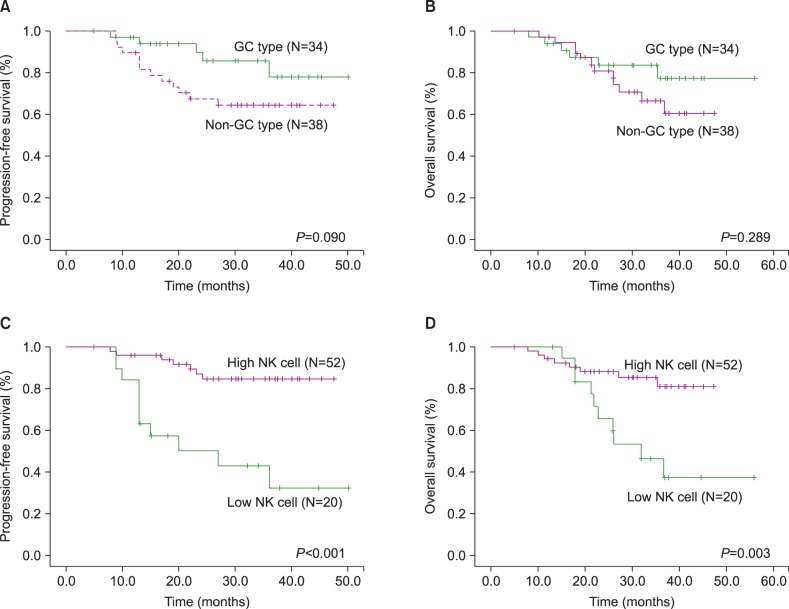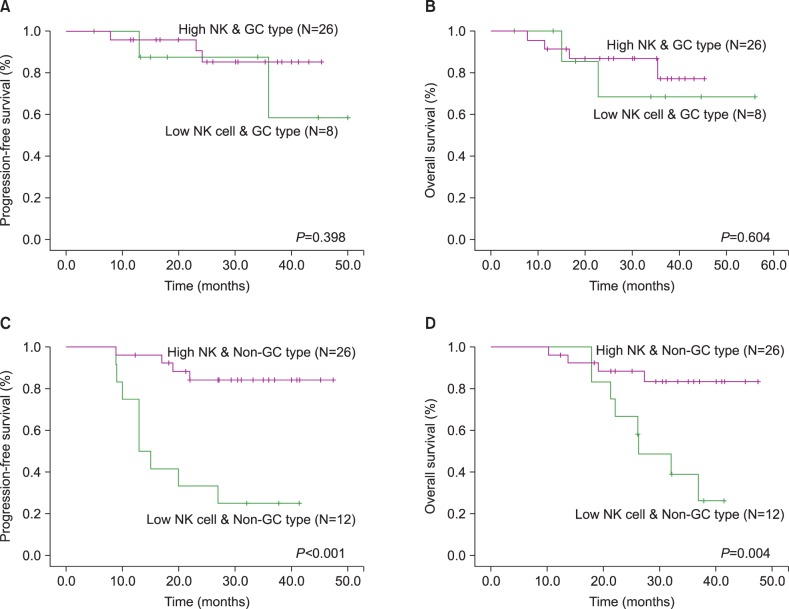Blood Res.
2014 Sep;49(3):162-169. 10.5045/br.2014.49.3.162.
Influence of NK cell count on the survival of patients with diffuse large B-cell lymphoma treated with R-CHOP
- Affiliations
-
- 1Department of Hematology-Oncology, Pusan National University Hospital Medical Research Institute, Busan, Korea. Hemon@pusan.ac.kr
- KMID: 2172787
- DOI: http://doi.org/10.5045/br.2014.49.3.162
Abstract
- BACKGROUND
Although adding rituximab to the chemotherapy regimen of cyclophosphamide, vincristine, doxorubicin, and prednisone (R-CHOP) has improved clinical outcomes of patients with diffuse large B-cell lymphoma (DLBCL), several recent studies have shown that the effect of rituximab is dominantly in the non-germinal center (non-GC) subtype compared to the germinal center (GC) subtype. Natural killer (NK) cell count, a surrogate marker of immune status, is associated with clinical outcomes in DLBCL patients in the rituximab era. We investigated whether the impact of NK cells on clinical outcomes differed according to the immunophenotype of DLBCL.
METHODS
This study analyzed 72 DLBCL patients treated with R-CHOP between January 2010 and January 2014.
RESULTS
Low NK cell counts (<100/microL) were associated with poor progression-free survival (PFS) and overall survival (OS) compared to high NK cell counts. In multivariate analysis, low NK cell count was an independent prognostic factor for PFS and OS. However, survival did not significantly differ between the GC and non-GC subtypes. We examined the clinical influence of NK cells according to the immunophenotype and found that low NK cell counts were significantly associated with poor PFS and OS in non-GC cases, but not in GC cases.
CONCLUSION
Low NK cell counts at diagnosis are associated with poor clinical outcomes in DLBCL patients treated with R-CHOP therapy. However, the impact is significant only in non-GC subtype DLBCL, not in the GC subtype.
Keyword
MeSH Terms
Figure
Cited by 1 articles
-
Way to go to exploit NK cells' versatile talents for cancer immunotherapy
Duck Cho
Blood Res. 2014;49(3):139-140. doi: 10.5045/br.2014.49.3.139.
Reference
-
1. Hans CP, Weisenburger DD, Greiner TC, et al. Confirmation of the molecular classification of diffuse large B-cell lymphoma by immunohistochemistry using a tissue microarray. Blood. 2004; 103:275–282. PMID: 14504078.
Article2. Berglund M, Thunberg U, Amini RM, et al. Evaluation of immunophenotype in diffuse large B-cell lymphoma and its impact on prognosis. Mod Pathol. 2005; 18:1113–1120. PMID: 15920553.
Article3. van Imhoff GW, Boerma EJ, van der Holt B, et al. Prognostic impact of germinal center-associated proteins and chromosomal breakpoints in poor-risk diffuse large B-cell lymphoma. J Clin Oncol. 2006; 24:4135–4142. PMID: 16943530.
Article4. Feugier P, Van Hoof A, Sebban C, et al. Long-term results of the R-CHOP study in the treatment of elderly patients with diffuse large B-cell lymphoma: a study by the Groupe d'Etude des Lymphomes de l'Adulte. J Clin Oncol. 2005; 23:4117–4126. PMID: 15867204.
Article5. Pfreundschuh M, Trumper L, Osterborg A, et al. CHOP-like chemotherapy plus rituximab versus CHOP-like chemotherapy alone in young patients with good-prognosis diffuse large-B-cell lymphoma: a randomised controlled trial by the MabThera International Trial (MInT) Group. Lancet Oncol. 2006; 7:379–391. PMID: 16648042.6. Plonquet A, Haioun C, Jais JP, et al. Peripheral blood natural killer cell count is associated with clinical outcome in patients with aaIPI 2-3 diffuse large B-cell lymphoma. Ann Oncol. 2007; 18:1209–1215. PMID: 17496307.
Article7. Martelli M, Ferreri AJ, Agostinelli C, Di Rocco A, Pfreundschuh M, Pileri SA. Diffuse large B-cell lymphoma. Crit Rev Oncol Hematol. 2013; 87:146–171. PMID: 23375551.
Article8. Reber R, Banz Y, Garamvolgyi E, Perren A, Novak U. Determination of the molecular subtypes of diffuse large B-cell lymphomas using immunohistochemistry: a case series from the Inselspital, Bern, and a critical appraisal of this determination in Switzerland. Swiss Med Wkly. 2013; 143:w13748. PMID: 23740154.
Article9. Fisher SG, Fisher RI. The epidemiology of non-Hodgkin's lymphoma. Oncogene. 2004; 23:6524–6534. PMID: 15322522.
Article10. The Non-Hodgkin's Lymphoma Classification Project. A clinical evaluation of the International Lymphoma Study Group classification of non-Hodgkins lymphoma. Blood. 1997; 89:3909–3918. PMID: 9166827.11. Campo E, Swerdlow SH, Harris NL, Pileri S, Stein H, Jaffe ES. The 2008 WHO classification of lymphoid neoplasms and beyond: evolving concepts and practical application. Blood. 2011; 117:5019–5032. PMID: 21300984.12. Flowers CR, Sinha R, Vose JM. Improving outcomes for patients with diffuse large B-cell lymphoma. CA Cancer J Clin. 2010; 60:393–408. PMID: 21030533.
Article13. Castillo JJ, Beltran BE, Song MK, et al. The Hans algorithm is not prognostic in patients with diffuse large B-cell lymphoma treated with R-CHOP. Leuk Res. 2012; 36:413–417. PMID: 22277681.
Article14. Kim DH, Baek JH, Chae YS, et al. Absolute lymphocyte counts predicts response to chemotherapy and survival in diffuse large B-cell lymphoma. Leukemia. 2007; 21:2227–2230. PMID: 17554383.
Article15. Cox MC, Nofroni I, Laverde G, et al. Absolute lymphocyte count is a prognostic factor in diffuse large B-cell lymphoma. Br J Haematol. 2008; 141:265–268. PMID: 18353165.
Article16. Oki Y, Yamamoto K, Kato H, et al. Low absolute lymphocyte count is a poor prognostic marker in patients with diffuse large B-cell lymphoma and suggests patients' survival benefit from rituximab. Eur J Haematol. 2008; 81:448–453. PMID: 18691256.
Article17. Plosker GL, Figgitt DP. Rituximab: a review of its use in non-Hodgkin's lymphoma and chronic lymphocytic leukaemia. Drugs. 2003; 63:803–843. PMID: 12662126.18. Weiner GJ. Rituximab: mechanism of action. Semin Hematol. 2010; 47:115–123. PMID: 20350658.
Article19. Nyman H, Adde M, Karjalainen-Lindsberg ML, et al. Prognostic impact of immunohistochemically defined germinal center phenotype in diffuse large B-cell lymphoma patients treated with immunochemotherapy. Blood. 2007; 109:4930–4935. PMID: 17299093.
Article20. Saito B, Shiozawa E, Usui T, et al. Rituximab with chemotherapy improves survival of non-germinal center type untreated diffuse large B-cell lymphoma. Leukemia. 2007; 21:2563–2566. PMID: 17597802.
Article21. Pavan A, Spina M, Canzonieri V, Sansonno S, Toffoli G, De Re V. Recent prognostic factors in diffuse large B-cell lymphoma indicate NF-kappaB pathway as a target for new therapeutic strategies. Leuk Lymphoma. 2008; 49:2048–2058. PMID: 19021048.22. Dunleavy K, Wilson WH. Appropriate management of molecular subtypes of diffuse large B-cell lymphoma. Oncology (Williston Park). 2014; 28:326–334. PMID: 24839807.
- Full Text Links
- Actions
-
Cited
- CITED
-
- Close
- Share
- Similar articles
-
- Prognostic Significance of Neutrophil Lymphocyte Ratio and Platelet Lymphocyte Ratio in Diffuse Large B-Cell Lymphoma Patients Treated with R-CHOP
- A Case of Extranodall NK/T-cell Lymphoma, Nasal type
- Treatment results of radiotherapy following CHOP or R-CHOP in limited-stage head-and-neck diffuse large B-cell lymphoma: a single institutional experience
- A Case of Primary Adrenal Diffuse Large B-cell Lymphoma Achieving Complete Remission with Rituximab-CHOP Chemotherapy
- Diffuse Large B-cell Lymphoma Successfully Treated in a Pregnant Patient



